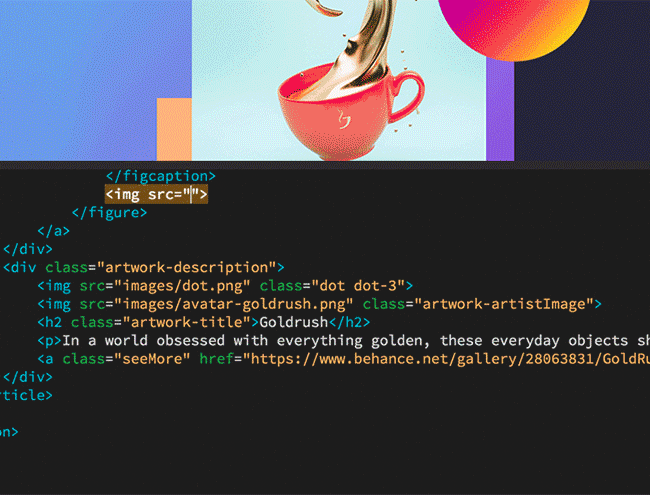If you're diving into web development, you've likely come across Adobe Dreamweaver and Behance. Both platforms serve pivotal roles in their respective industries. Dreamweaver is a powerful web design and development tool that provides developers with the ability to create and manage websites with ease. It offers visual design capabilities alongside robust coding features, making it a favorite among both beginners and advanced users.
On the other hand, Behance is a global platform that showcases creative work across various fields, including web design. It's where designers can display their portfolios, gain feedback, and inspire others. The intersection of these two platforms creates unique opportunities for web developers looking to enhance their skills and understand the best practices in web design.
Why View Dreamweaver Code on Behance?

Diving into the source code of projects on Behance that were created with Dreamweaver can be incredibly beneficial for several reasons. Let's explore why you should consider this approach:
- Real-World Examples: Seeing how others structure their code gives you insights into real-world applications and solutions.
- Learn Best Practices: By analyzing code from experienced developers, you can identify design patterns and techniques that are widely accepted in the industry.
- Enhance Your Skills: Exposure to different coding styles helps you expand your skill set and adapt new methods to your own projects.
When you're navigating through Behance to explore Dreamweaver projects, you're not just looking at finished designs; you're peeking behind the curtain to see how those creations came to life. This can make a significant difference in your learning curve.
Community Feedback: Many creatives on Behance encourage comments and discussions about their work. Engaging with these projects can lead to valuable feedback not only on the design itself but on the code behind it. You might discover practices you hadn’t considered before, such as:
- Efficient use of CSS for styling
- Responsive design techniques
- JavaScript integrations for dynamic functionality
Furthermore, when you know that a project was developed in Dreamweaver, you can also appreciate specific functionality or designs that leverage Dreamweaver’s unique offerings. For instance, its built-in code hints and server-side capabilities can dramatically streamline your development workflow.
Expand Your Network: Behance isn’t just about viewing projects; it’s a community. By engaging with the code you admire, you can connect with other creators, ask questions, and even find mentors who can help guide you in your web development journey.
In summary, viewing Dreamweaver code on Behance not only allows you to learn and grow but fosters a sense of community and support amongst web developers. So, as you continue exploring projects, don’t forget to take notes on the code and practices that resonate with you. You might just discover the key to elevating your web development game!
Also Read This: How to Delete Behance Profile: Steps to Permanently Remove Your Account
3. Step-by-Step Guide to Accessing Dreamweaver Code on Behance

If you're keen on diving into the world of web development using Dreamweaver, accessing the right code can be a game-changer. Behance, being a vibrant hub for creatives, has numerous projects where you can find inspiration and often the source code itself. Let's break down the steps on how to access Dreamweaver code on Behance effectively.
Step 1: Create a Behance Account
If you haven't already, the first step is to sign up for a free account on Behance. Just head over to the Behance website and follow the simple registration process. This will allow you to follow projects, interact with other creatives, and most importantly, download files where permitted.
Step 2: Use the Search Bar
Step 3: Filter Your Results
Behance allows you to filter results based on different criteria such as "Most Appreciated", "Latest", or specific tools used. Use these filters to narrow down to projects that not only catch your eye but also utilize Dreamweaver.
Step 4: Explore Project Details
Once you find a project that interests you, click on it to view more details. Most project pages typically feature visuals, descriptions, and sometimes a lot of detailed documentation on the code.
Step 5: Downloading Resources
Look for options like "Download" on the project page. Not all projects will have downloadable files, but many creators share source files, including Dreamweaver documents. If they are available, you'll likely find them under sections labeled as such. Tap the download button, and follow the prompts to get the files onto your computer.
Step 6: Importing to Dreamweaver
Once you've downloaded the files, it’s time to import them into Dreamweaver. Open your Dreamweaver application, go to File > Open, and select the HTML files you downloaded. From here, you can start playing around, customizing, and even learning the code structure.
And just like that, you're on your way to enhancing your web development skills with the resources obtained from Behance! Remember, the key is to explore, get inspired, and don’t hesitate to reach out to other creators for questions or collaborations.
Also Read This: Easy Methods to Download Content from Behance.net
4. Understanding the Code Structure in Dreamweaver

Understanding the code structure in Dreamweaver is critical for anyone looking to master web development. Dreamweaver uses HTML, CSS, JavaScript, and other web technologies, which means familiarizing yourself with these languages will take your coding skills to the next level. Let’s break down some of the essential components.
1. HTML Structure
HTML (HyperText Markup Language) forms the backbone of any website. In Dreamweaver, you’ll see a layout structured with various HTML tags like <header>, <footer>, <section>, and <div>. Each of these tags serves a purpose and is crucial for organizing your content. Here’s a basic overview:
<header>: Typically contains your site title and navigation links.<footer>: Contains information like copyright notices and additional links.<section>: Defines sections in your content, which is useful for layout.<div>: Generic container for content, often used for styling with CSS.
2. CSS Styling
Cascading Style Sheets (CSS) is what controls the look and feel of your website. In Dreamweaver, CSS can be internal (within the HTML file) or external (linked from a separate file). Understanding the CSS box model, including margin, padding, border, and content, is fundamental. Additionally, CSS selectors, properties, and values will help you style your elements. Some common selectors include:
.classname: Targets elements with a specific class.#idname: Targets an element with a specific ID.element: Targets all instances of that HTML element (likeh1).
3. JavaScript Interactivity
JavaScript adds interactivity to your websites. In Dreamweaver, you can write scripts directly in your HTML pages or link to external JS files. Familiarize yourself with basic functions, events, and DOM manipulation, as these will elevate your web development projects significantly.
By understanding these core components within Dreamweaver, you'll not only be able to create stunning web pages but also troubleshoot and enhance existing projects. With practice, you'll soon find that the structure becomes second nature, allowing you to focus more on creativity rather than code!
Also Read This: How to Download Videos from Behance
5. Tips for Effective Web Development Using Dreamweaver and Behance
When diving into web development with Dreamweaver and showcasing your work on Behance, it's essential to have a strategy that maximizes both your coding experience and your project's visibility. Here are some effective tips to help you get the most out of these tools:
- Leverage Code View and Design View: Dreamweaver offers a unique split view where you can simultaneously see your code and the design interface. This is particularly helpful for beginners as it allows you to visualize changes in real-time. As you make edits to your code, observe how it affects the design layout right before your eyes!
- Utilize Templates: Templates can save you a ton of time. Create a template for recurring design elements across your project and apply it consistently. This not only helps maintain uniformity but also simplifies updates!
- Integrate with Popular Frameworks: Dreamweaver supports several popular frameworks like Bootstrap and Foundation. Take advantage of these frameworks to speed up your development process. They provide pre-designed components and responsive features that can elevate your designs.
- Keep Accessibility in Mind: While creating stunning designs, remember to ensure accessibility. Use Dreamweaver's built-in validation tools to check for issues and ensure that your site is usable by everyone, including those with disabilities.
- Showcase Your Work on Behance: Once you've developed a project, don’t forget to showcase it on Behance. Make your project stand out by providing detailed descriptions, including the challenges you faced and how you overcame them. Engaging with your audience through comments also fosters a community.
- Document Your Process: While developing, document your process. This can be in the form of screenshots, notes, or even video tutorials. Sharing your journey on Behance not only showcases your skills but also helps others looking to learn.
By incorporating these tips into your web development process, you can streamline your workflow, build impressive projects, and impress potential clients or employers on Behance!
Also Read This: How to Find Friends on Behance: Connecting with Fellow Creatives
6. Common Challenges and Solutions
While Dreamweaver and Behance offer amazing tools for web development, there are common challenges that many developers face. Let's go over these challenges and provide some handy solutions:
| Challenge | Solution |
|---|---|
| Confusion with HTML and CSS Syntax | Localize your resources. Utilize Dreamweaver's built-in tutorials and resource panel. Regular practice and referencing documentation can significantly help in solidifying your understanding. |
| Browser Compatibility Issues | Test your website on multiple browsers (Chrome, Firefox, Safari) using Dreamweaver’s preview options. Tools like BrowserStack or cross-browser testing can also help identify discrepancies. |
| Long Learning Curve | Break learning into bite-sized sections. Set manageable goals, such as mastering one feature of Dreamweaver each week, and practice before moving on. |
| Maintaining Design Consistency | Utilize Design Systems or style guides. Keep a consistent palette, fonts, and layout templates within Dreamweaver to ensure visual harmony. |
| Limited Visibility on Behance | Engage with the Behance community! Comment on others' work, and participate in groups. Regularly update your portfolio to keep it fresh and relevant. |
By being aware of these challenges and applying the proposed solutions, you can enhance your experience in web development with Dreamweaver and make the most out of your portfolio on Behance. Remember, every challenge is an opportunity for growth! Keep pushing your boundaries, and you'll see impressive results over time.
Conclusion: Enhancing Your Web Development Skills
As an aspiring web developer, continuously improving your skill set is crucial for staying competitive in the industry. Leveraging resources like Behance to view Dreamweaver code can significantly enhance your learning experience. Here are some key takeaways to consider:
- Learn from Real Projects: By examining the code of completed projects, you can gain insights into various coding practices and styles.
- Understand Design Principles: Viewing how experienced developers structure their projects will help you grasp essential design concepts.
- Experiment with Code: Don’t just view; actively replicate and modify the code to see how changes affect functionality.
Additionally, consider the following strategies:
| Strategy | Description |
|---|---|
| Join Online Communities | Participate in forums and social media groups dedicated to web development for knowledge sharing. |
| Continuous Learning | Engage in online courses and workshops to stay updated with the latest trends and technologies. |
| Build a Portfolio | Create and showcase your own projects, applying the skills you learned from watching others. |
In conclusion, exploring Dreamweaver code on platforms like Behance is not just about passive observation; it’s an opportunity to actively engage with coding and design. By utilizing these strategies, you can accelerate your development journey and build a solid foundation for your future projects.
 admin
admin








